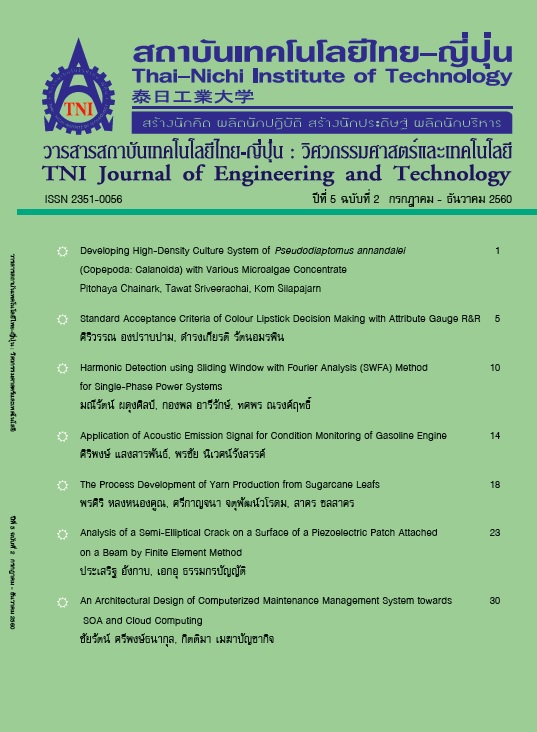Harmonic Detection using Sliding Window with Fourier Analysis (SWFA) Method for Single-Phase Power Systems
Main Article Content
Abstract
This paper presents a harmonic detection using Sliding Window with Fourier Analysis (SWFA) for computing the reference current of active power filter in single-phase power systems. The SWFA method is able to detect harmonic accurately and precisely with rapid processing. Ideal current source is used as active power filter for focusing on the harmonic detection performance. For testing the harmonic elimination, the SimPowerSystems Blockset and Simulink in MATLAB were used for simulation program. Therefore, The simulation result shows that the active power filter with the reference current computed by SWFA can provide the good performance compensation. The source current after compensation are nearly sinusoidal waveform and the total harmonic distortion (%THD) follows the frame of IEEE std.519-2014
Article Details
Article Accepting Policy
The editorial board of Thai-Nichi Institute of Technology is pleased to receive articles from lecturers and experts in the fields of engineering and technology written in Thai or English. The academic work submitted for publication must not be published in any other publication before and must not be under consideration of other journal submissions. Therefore, those interested in participating in the dissemination of work and knowledge can submit their article to the editorial board for further submission to the screening committee to consider publishing in the journal. The articles that can be published include solely research articles. Interested persons can prepare their articles by reviewing recommendations for article authors.
Copyright infringement is solely the responsibility of the author(s) of the article. Articles that have been published must be screened and reviewed for quality from qualified experts approved by the editorial board.
The text that appears within each article published in this research journal is a personal opinion of each author, nothing related to Thai-Nichi Institute of Technology, and other faculty members in the institution in any way. Responsibilities and accuracy for the content of each article are owned by each author. If there is any mistake, each author will be responsible for his/her own article(s).
The editorial board reserves the right not to bring any content, views or comments of articles in the Journal of Thai-Nichi Institute of Technology to publish before receiving permission from the authorized author(s) in writing. The published work is the copyright of the Journal of Thai-Nichi Institute of Technology.
References
A. Hiranandani, “Calculation of cable ampacities including the effects of harmonics,” IEEE Industry Applications Magazine, vol. 4, no. 2, pp. 42–51, Mar. 1998.
V. E. Wagner et al., “Effects of harmonics on equipment,” IEEE Transactions on Power Delivery, vol. 8, no. 2, pp. 672–680, Apr. 1993.
R. D. Henderson and P. J. Rose, “Harmonics: the effects on power quality and transformers,” IEEE Transactions on Industry Applications, vol. 30, no. 3, pp. 528–532, May 1994.
D. E. Rice, “Adjustable Speed Drive and Power Rectifier Harmonics-Their Effect on Power Systems Components,” IEEE Transactions on Industry Applications, vol. IA-22, no. 1, pp. 161–177, Jan. 1986.
“IEEE Recommended Practice and Requirements for Harmonic Control in Electric Power Systems,” IEEE Std 519-2014 (Revision of IEEE Std 519-1992), pp. 1–29, Jun. 2014.
G. W. Chang, H.-L. Wang, and S.-Y. Chu, “Strategic placement and sizing of passive filters in a power system for controlling voltage distortion,” IEEE Transactions on Power Delivery, vol. 19, no. 3, pp. 1204–1211, Jul. 2004.
M. Rukonuzzaman and M. Nakaoka, “Single-phase shunt active power filter with harmonic detection,” IEE Proceedings - Electric Power Applications, vol. 149, no. 5, pp. 343–350, Sep. 2002.
P. K. Ray, G. Panda, and P. S. Puhan, “Fuzzy logic based intelligent Shunt Hybrid filter applied to single phase system,” in 2013 Annual IEEE India Conference (INDICON), 2013, pp. 1–6.
M. El-Habrouk, M. K. Darwish, and P. Mehta, “A survey of active filters and reactive power compensation techniques,” in 2000 Eighth International Conference on Power Electronics and Variable Speed Drives (IEE Conf. Publ. No. 475), 2000, pp. 7–12.
J. Barros and E. Perez, “An adaptive method for determining the reference compensating current in single-phase shunt active power filters,” IEEE Transactions on Power Delivery, vol. 18, no. 4, pp. 1578–1580, Oct. 2003.
V. Khadkikar, A. Chandra, and B. N. Singh, “Generalised single-phase p-q theory for active power filtering: simulation and DSP-based experimental investigation,” IET Power Electronics, vol. 2, no. 1, pp. 67–78, Jan. 2009.
B. Han, “Single-phase active power filter using FFT with harmonic phase-delay compensation,” in 2009 IEEE Power Energy Society General Meeting, 2009, pp. 1–6.
B. A. Angélico, L. B. G. Campanhol, and S. A. O. da Silva, “Proportional–integral/proportional–integralderivative tuning procedure of a single-phase shunt active power filter using Bode diagram,” IET Power Electronics, vol. 7, no. 10, pp. 2647–2659, 2014.
S. Tiyarachakun, K. Areerak, and K. Areerak, “Instantaneous Power Theory with Fourier and Optimal Predictive Controller Design for Shunt Active Power Filter,” Modelling and Simulation in Engineering, vol. 2014, pp. 1–20, Jan. 2014.


